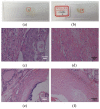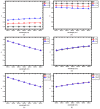Characterizing microstructures of cancerous tissues using multispectral transformed Mueller matrix polarization parameters
- PMID: 26309757
- PMCID: PMC4541521
- DOI: 10.1364/BOE.6.002934
Characterizing microstructures of cancerous tissues using multispectral transformed Mueller matrix polarization parameters
Abstract
In this paper, we take the transmission 3 × 3 linear polarization Mueller matrix images of the unstained thin slices of human cervical and thyroid cancer tissues, and analyze their multispectral behavior using the Mueller matrix transformation (MMT) parameters. The experimental results show that for both cervical and thyroid cancerous tissues, the characteristic features of multispectral transmitted MMT parameters can be used to distinguish the normal and abnormal areas. Moreover, Monte Carlo simulations based on the sphere-cylinder birefringence model (SCBM) provide additional information of the relations between the characteristic spectral features of the MMT parameters and the microstructures of the tissues. Comparisons between the experimental and simulated data confirm that the contrast mechanism of the transmission MMT imaging for cancer detection is the breaking down of birefringent normal tissues for cervical cancer, or the formation of birefringent surrounding structures accompanying the inflammatory reaction for thyroid cancer. It is also testified that, the characteristic spectral features of polarization imaging techniques can provide more detailed microstructural information of tissues for diagnosis applications.
Keywords: (110.5405) Polarimetric imaging; (170.3880) Medical and biological imaging; (290.5855) Scattering, polarization.
Figures









References
LinkOut - more resources
Full Text Sources
